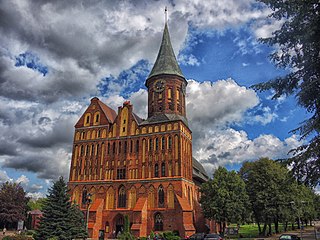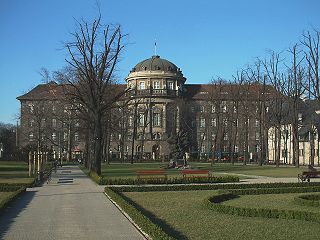
The Polish Corridor, also known as the Danzig Corridor, Corridor to the Sea or Gdańsk Corridor, was a territory located in the region of Pomerelia, which provided the Second Republic of Poland (1920–1939) with access to the Baltic Sea, thus dividing the bulk of Weimar Germany from the province of East Prussia. At its narrowest point, the Polish territory was just 30 km wide. The Free City of Danzig, situated to the east of the corridor, was a semi-independent German speaking city-state forming part of neither Germany nor Poland, though united with the latter through an imposed union covering customs, mail, foreign policy, railways as well as defence.

The Kingdom of Prussia constituted the German state of Prussia between 1701 and 1918. It was the driving force behind the unification of Germany in 1866 and was the leading state of the German Empire until its dissolution in 1918. Although it took its name from the region called Prussia, it was based in the Margraviate of Brandenburg. Its capital was Berlin.

The Masurians or Mazurs, historically also known as Prussian Masurians, are an ethnic group originating from the region of Masuria, within the Warmian-Masurian Voivodeship, Poland. They number around 5,000–15,000 people. In the 2011 Polish census, 1,376 individuals declared themselves to be Masurian as either a first or a secondary identification. Before World War II and its post-war expulsions, Masurians used to be a more numerous ethnic group found in the southern parts of East Prussia for centuries following the 16th century Protestant Reformation. Today, most Masurians live in what is now Germany and elsewhere.

The Duchy of Warsaw, also known as the Grand Duchy of Warsaw and Napoleonic Poland, was a French client state established by Napoleon Bonaparte in 1807, during the Napoleonic Wars. It initially comprised the ethnically Polish lands ceded to France by Prussia under the terms of the Treaties of Tilsit, and was augmented in 1809 with territory ceded by Austria in the Treaty of Schönbrunn. It was the first attempt to re-establish Poland as a sovereign state after the 18th-century partitions and covered the central and southeastern parts of present-day Poland.

Prussia is a historical region in Central Europe on the south-eastern coast of the Baltic Sea, that ranges from the Vistula delta in the west to the end of the Curonian Spit in the east and extends inland as far as Masuria, divided between Poland, Russia and Lithuania.

The Grand Duchy of Posen was part of the Kingdom of Prussia, created from territories annexed by Prussia after the Partitions of Poland, and formally established following the Napoleonic Wars in 1815. Per agreements derived at the Congress of Vienna it was to have some autonomy. However, in reality it was subordinated to Prussia and the proclaimed rights for Polish subjects were not fully implemented. On 9 February 1849, the Prussian administration renamed the grand duchy the Province of Posen. Its former name was unofficially used afterward for denoting the territory, especially by Poles, and today is used by modern historians to refer to different political entities until 1918. Its capital was Posen.

The Province of Silesia was a province of Prussia from 1815 to 1919. The Silesia region was part of the Prussian realm since 1742 and established as an official province in 1815, then became part of the German Empire in 1871. In 1919, as part of the Free State of Prussia within Weimar Germany, Silesia was divided into the provinces of Upper Silesia and Lower Silesia. Silesia was reunified briefly from 1 April 1938 to 27 January 1941 as a province of Nazi Germany before being divided back into Upper Silesia and Lower Silesia.

The Frontier March of Posen–West Prussia was a province of Prussia from 1922 to 1938, covering most of lands of historical Greater Poland that were not included in Second Polish Republic. Posen–West Prussia was established in 1922 as a province of the Free State of Prussia within Weimar Germany, formed from merging three remaining non-contiguous territories of Posen and West Prussia, which had lost the majority of their territory to the Second Polish Republic following the Greater Poland Uprising. From 1934, Posen–West Prussia was de facto ruled by Brandenburg until it was dissolved by Nazi Germany, effective 1 October 1938 and its territory divided between the provinces of Pomerania, Brandenburg and Silesia. Schneidemühl was the provincial capital. Today, lands of the province are entirely contained within Poland.

South Prussia was a province of the Kingdom of Prussia from 1793 to 1807.

Kreis Birnbaum was a district in Prussia (Kreis) in the west of the Grand Duchy of Posen and the succeeding Province of Posen, as part of Regierungsbezirk Posen between 1815 and 1920. Today the area belongs to the Polish voivodeships of Greater Poland and Lubusz.

The Prussian Settlement Commission, officially known as the Royal Prussian Settlement Commission in the Provinces West Prussia and Posen was a Prussian government commission that operated between 1886 and 1924, but actively only until 1918. It was set up by Otto von Bismarck to increase land ownership by ethnically German Germans at the expense of ethnically Polish Germans, by economic and political means, in Prussia's eastern provinces of West Prussia and the Posen as part of his larger efforts aiming at the eradication of the Polish nation. The commission was motivated by German racism.
Germanisation, or Germanization, is the spread of the German language, people, and culture. It was a central idea of German conservative thought in the 19th and the 20th centuries, when conservatism and ethnic nationalism went hand in hand. In linguistics, Germanisation of non-German languages also occurs when they adopt many German words.

The Province of Posen was a province of the Kingdom of Prussia from 1848 to 1920, occupying most of the historical Greater Poland. The province was established following the Poznań Uprising of 1848 as a successor to the Grand Duchy of Posen, which in turn was annexed by Prussia in 1815 from Duchy of Warsaw. It became part of the German Empire in 1871. After World War I, Posen was briefly part of the Free State of Prussia within Weimar Germany, but was dissolved in 1920 when most of its territory was ceded to the Second Polish Republic as a result of the Greater Poland Uprising. The remaining German territory was re-organized into Posen-West Prussia in 1922.

The Province of West Prussia was a province of Prussia from 1773 to 1829 and 1878 to 1920. West Prussia was established as a province of the Kingdom of Prussia in 1773, formed from Royal Prussia of the Polish–Lithuanian Commonwealth annexed in the First Partition of Poland. West Prussia was dissolved in 1829 and merged with East Prussia to form the Province of Prussia, but was re-established in 1878 when the merger was reversed and became part of the German Empire. From 1918, West Prussia was a province of the Free State of Prussia within Weimar Germany, losing most of its territory to the Second Polish Republic and the Free City of Danzig in the Treaty of Versailles. West Prussia was dissolved in 1920, and its remaining western territory was merged with Posen to form Posen-West Prussia, and its eastern territory merged with East Prussia as the Region of West Prussia district.

The Greater Poland uprising of 1848 or Poznań Uprising was an unsuccessful military insurrection of Poles against forces of the Kingdom of Prussia, during the Revolutions of 1848. The main fighting in the Prussian Partition of Poland was concentrated in the Greater Poland region but some fighting also occurred in Pomerelia. In addition, protests were also held in Polish inhabited regions of Silesia.

Poles in Germany are the second largest Polish diaspora (Polonia) in the world and the biggest in Europe. Estimates of the number of Poles living in Germany vary from 2 million to about 3 million people living that might be of Polish descent. Their number has quickly decreased over the years, and according to the latest census, there are approximately 866,690 Poles in Germany. The main Polonia organisations in Germany are the Union of Poles in Germany and Congress of Polonia in Germany. Polish surnames are relatively common in Germany, especially in the Ruhr area.
German Eastern Marches Society was a German radical, extremely nationalist xenophobic organization founded in 1894. Mainly among Poles, it was sometimes known acronymically as Hakata or H-K-T after its founders von Hansemann, Kennemann and von Tiedemann. Its main aims were the promotion of Germanization of Poles living in Prussia and destruction of Polish national identity in German eastern provinces. Contrary to many similar nationalist organizations created in that period, the Ostmarkenverein had relatively close ties with the government and local administration, which made it largely successful, even though it opposed both the policy of seeking some modo vivendi with the Poles pursued by Chancellor Theobald von Bethmann Hollweg and Leo von Caprivi's policies of relaxation of anti-Polish measures. While of limited significance and often overrated, the organization formed a notable part of German anti-democratic pluralist part of the political landscape of the Wilhelmine era.
The term "Lesser Germany" or "Lesser German solution" denoted essentially exclusion of the multinational Austria of the Habsburgs from the planned German unification as an option for solving the German question, in opposition to the one of 'Greater Germany'.

The Prussian Partition, or Prussian Poland, is the former territories of the Polish–Lithuanian Commonwealth acquired during the Partitions of Poland, in the late 18th century by the Kingdom of Prussia. The Prussian acquisition amounted to 141,400 km2 of land constituting formerly western territory of the Commonwealth. The first partitioning led by imperial Russia with Prussian participation took place in 1772; the second in 1793, and the third in 1795, resulting in Poland's elimination as a state for the next 123 years.

The Germanisation of the Province of Posen was a policy of the Kulturkampf measures enacted by German Chancellor Otto von Bismarck, whose goal was to Germanize Polish-speaking areas in the Prussian Province of Posen by eradicating and discrimination of Polish language and culture, as well as to reduce the influence of the "ultramontanist" Roman Catholic clergy in those regions.

















